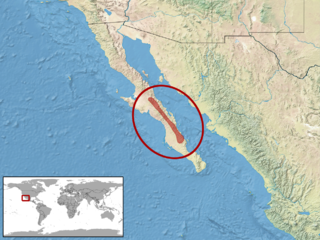
Amphisbaenia is a group of typically legless lizards, comprising over 200 extant species. Amphisbaenians are characterized by their long bodies, the reduction or loss of the limbs, and rudimentary eyes. As many species have a pink body and scales arranged in rings, they have a superficial resemblance to earthworms. While the genus Bipes retains forelimbs, all other genera are limbless. Phylogenetic studies suggest that they are nested within Lacertoidea, closely related to the lizard family Lacertidae. Amphisbaenians are widely distributed, occurring in North America, Europe, Africa, South America, Western Asia and the Caribbean. Most species are less than 6 inches (15 cm) long.

Anguidae refers to a large and diverse family of lizards native to the Northern Hemisphere. Common characteristics of this group include a reduced supratemporal arch, striations on the medial faces of tooth crowns, osteoderms, and a lateral fold in the skin of most taxa. The group is divided into two living subfamilies, the legless Anguinae, which contains slow worms and glass lizards, among others, found across the Northern Hemisphere, and Gerrhonotinae, which contains the alligator lizards, native to North and Central America. The family Diploglossidae was also formerly included. The family contains about 87 species in 8 genera.

Leiocephalidae, also known as the curlytail lizards or curly-tailed lizards, is a family of iguanian lizards restricted to the West Indies. One of the defining features of these lizards is that their tail often curls over. They were previously regarded as members of the subfamily Leiocephalinae within the family Tropiduridae. There are presently 30 known species, all in the genus Leiocephalus.

Elgaria is a genus of New World lizards in the family Anguidae. Their common name is western alligator lizards.

The southern alligator lizard is a common species of lizard in the family Anguidae. The species is native to the Pacific coast of North America. It ranges from Baja California to the state of Washington and lives in a variety of habitats including grasslands, chaparral, forests, and even urban areas. In dry climates, it is likely to be found in moist areas or near streams. There are five recognized subspecies.

The northern alligator lizard is a species of medium-sized lizard in the family Anguidae. The species is endemic to the North American west coast.
An alligator lizard is any one of various species of lizards in the family Anguidae that have some shared characteristics. The term may specifically refer to:

The Panamint alligator lizard is a species of lizard in the Anguidae family.

The Transvaal grass lizard, also known as the coppery grass lizard and Transvaal snake lizard is a species of lizard in the genus Chamaesaura. It is found in southern African grasslands and on slopes. The Transvaal grass lizard is ovoviviparous. The scientific name refers to its copper colour.

The Guatemalan beaded lizard, also called commonly the Motagua Valley beaded lizard, is a highly endangered species of beaded lizard, a venomous lizard in the family Helodermatidae. The species is endemic to the dry forests of the Motagua Valley in southeastern Guatemala, an ecoregion known as the Motagua Valley thornscrub. It is the only allopatric beaded lizard species, separated from the nearest population by 250 km (160 mi) of unsuitable habitat. The Guatemalan beaded lizard is the rarest and most endangered species of beaded lizard, and it is believed that fewer than 200 individuals of this animal exist in the wild, making it one of the most endangered lizards in the world. In 2007, it was transferred from Appendix II to Appendix I of CITES due to its critical conservation status.
The Pilbara monitor, also known commonly as Bush's monitor, Bush's pygmy monitor, and the Pilbara mulga goanna, is a species of monitor lizard in the family Varanidae. The species is endemic to Australia.

Urosaurus nigricauda is a species of lizard. Common names for this species include the Baja California brush lizard, black-tailed brush lizard, and small-scaled tree lizard. Its range includes southern California, Baja California, and nearby Pacific islands.
Cope's arboreal alligator lizard is a species of lizard found in two isolated locations in Guatemala, one in the Alta Verapaz Department and one in the Jalapa Department. These lizard are found only in high altitudes of 2,000 to 2,600 feet above sea level, on the west and south sides of the mountain ranges. This lizard is one of 28 species of alligator lizards, most being arboreal, meaning they live in trees. These omnivores are considered endangered because of their small population size and they face extinction due to habitat degradation and from pressures of the pet trade.

The Madrean alligator lizard, also known commonly as King's alligator lizard and el lagarto de montaña in Mexican Spanish, is a species of lizard in the family Anguidae. The species is native to the southwestern United States and adjacent northwestern Mexico.
Isla San Martín is an island in the Pacific Ocean west of the Baja California Peninsula. The island is uninhabited and is part of the Ensenada Municipality.

Pseudocordylus melanotus, also known as the common crag lizard or Highveld crag lizard, is a species of lizard found in Eswatini, Lesotho, and South Africa. Pseudocordylus subviridis is considered a distinct species by the Reptile Database, but a subspecies of Pseudocordylus melanotus by IUCN.
The Cedros Island alligator lizard is a species of medium-sized lizard in the family Anguidae. The species is endemic to Mexico.

The central peninsular alligator lizard is a species of medium-sized lizard in the family Anguidae. The species is endemic to Mexico.















